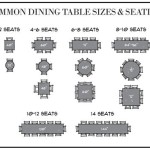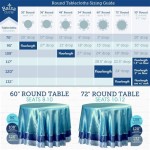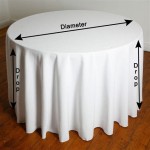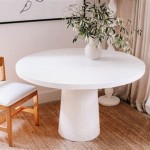```html
How Many People Fit At A 60-Inch Round Table?
Determining the ideal number of people to seat at a 60-inch round table is a common consideration for event planners, caterers, and individuals hosting gatherings at home. The answer is not a fixed number, as it depends on several factors, including the comfort level desired for guests, the type of event, and the amount of space needed for place settings, centerpieces, and serving dishes. While a 60-inch round table can technically accommodate a certain maximum number of individuals, prioritizing guest comfort and functionality is crucial for a successful and enjoyable event. Understanding these contributing elements allows for a more informed decision on seating arrangements.
Understanding the Ideal Comfort Zone
The most important factor to consider when determining seating capacity is the comfort of the guests. Overcrowding a table can lead to discomfort, difficulty in conversation, and an overall negative experience. The goal is to provide each guest with adequate personal space to eat, drink, and interact comfortably with others.
A general guideline is to allocate a minimum of 24 inches of table space per person. This measurement refers to the linear distance around the table’s circumference designated for each guest. This allows for reasonable elbow room and prevents guests from feeling cramped.
To calculate the comfortable seating capacity of a 60-inch round table using the 24-inch rule, one must first determine the circumference. The circumference of a circle is calculated using the formula C = πd, where C is the circumference, π (pi) is approximately 3.14159, and d is the diameter. In this case, the diameter is 60 inches, so the circumference is approximately 3.14159 * 60 = 188.5 inches.
Next, divide the circumference by the desired space per person (24 inches). This gives 188.5 / 24 = 7.85. Rounding down to the nearest whole number, it suggests that comfortably seating seven people at a 60-inch round table is ideal.
While this calculation suggests seven people, many event professionals recommend eight people as a standard. This is often deemed acceptable if place settings are relatively streamlined and there is no intention of placing large serving platters on the table. However, maintaining guest comfort should always be the foremost consideration.
The Impact of Place Settings and Table Decorations
The complexity and size of the place settings play a significant role in determining how many people can realistically fit around a 60-inch table. A simple place setting, consisting of a dinner plate, silverware, and a glass, will require less space than a formal place setting that includes multiple plates, several pieces of silverware, and various glasses. Consider the following:
Formal vs. Informal Events: Formal events typically have more elaborate place settings, potentially requiring more space per person. Informal gatherings might allow for simpler settings and therefore accommodate slightly more people.
The Size of the Dinnerware: Oversized dinner plates, chargers, or elaborate silverware can quickly consume valuable table real estate. Selecting streamlined and appropriately sized dinnerware can help maximize the available space.
Centerpieces and Decorations: The size and placement of centerpieces can significantly impact the usable space on the table. Large, elaborate centerpieces can obstruct views and limit the space available for place settings and serving dishes. Opting for smaller, less intrusive centerpieces can free up valuable space. Consider the height of the centerpieces as well. Those that are too tall can hinder conversation across the table.
Serving Dishes: If serving dishes are intended to be placed directly on the table, this will further reduce the available space per person. In this scenario, it is generally advisable to reduce the number of guests seated at the table to maintain a comfortable dining experience. The availability of buffet service or side tables for serving dishes can mitigate this issue.
Strategically planning the layout of the table, including the positioning of place settings and decorations, is vital. Visualizing the table setup beforehand, potentially by setting up a mock table, can help identify any potential space constraints and inform decisions about seating capacity.
Event Type and Guest Interaction
The type of event being hosted also influences the optimal number of guests to seat at a 60-inch round table. Events that prioritize conversation and interaction among guests might require a more spacious seating arrangement.
Business Meetings and Conferences: These events often involve note-taking, document sharing, and interaction with materials. Therefore, providing ample space is crucial to facilitate productivity and comfort. Seating fewer guests per table in such scenarios can be beneficial.
Weddings and Social Gatherings: While some events may accommodate tighter seating arrangements, maximizing space for guests to mingle and move around might be a priority. Crowding tables at a wedding reception can make navigating the room difficult and hinder guests' ability to interact with each other.
Family Gatherings: These gatherings can be more flexible, and attendees might be more tolerant of slightly tighter seating arrangements, particularly if the focus is on food and shared activities rather than formal conversation.
Accessibility Considerations: It's important to consider any guests with mobility limitations. Ensuring that there is adequate space around the table for wheelchairs or other mobility aids is crucial. This might necessitate reducing the number of guests seated at each table.
The desired atmosphere of the event should also be considered. A more relaxed and comfortable atmosphere might encourage guests to linger and interact, whereas a more formal event might prioritize efficiency and presentation. Tailoring the seating arrangement to the specific needs and objectives of the event is essential for creating a positive and memorable experience for all attendees.
Furthermore, consider the age range of the guests. Children generally require less space than adults. If the event is primarily attended by children, seating capacity might be slightly increased. However, safety and supervision should always be prioritized.
Ultimately, determining the ideal number of people to seat at a 60-inch round table requires careful consideration of several factors, including guest comfort, place setting complexity, and the nature of the event. By meticulously assessing these aspects, planners and hosts can create a comfortable and functional seating arrangement that enhances the overall experience for all attendees. While generalizations and rules of thumb can provide a starting point, adapting to the unique circumstances of each event ensures a successful and enjoyable occasion, ensuring that all guests feel welcomed and comfortable.
```
60 Round Table Seat 8 To 10 Destination Events

Pro Table Seating Guide

Seating Capacity For Round Rectangular Tables

60 Round Table Seat 8 To 10 Destination Events

60 In Round Table

Seating Calculator Does A 60 Inch Round Table Seat 8 Or 10 Reventals Event Als

Table Seating Capacity Contemporary Craftsman Furniture

The Right Number Of Chairs For Any Table Canadel S Blog

Amish Table Size Guide What Dining Do You Need

Dinner Table Set Up 10 Chairs Max Limit For 60 Inch Round Very Cozy Guests
Related Posts








